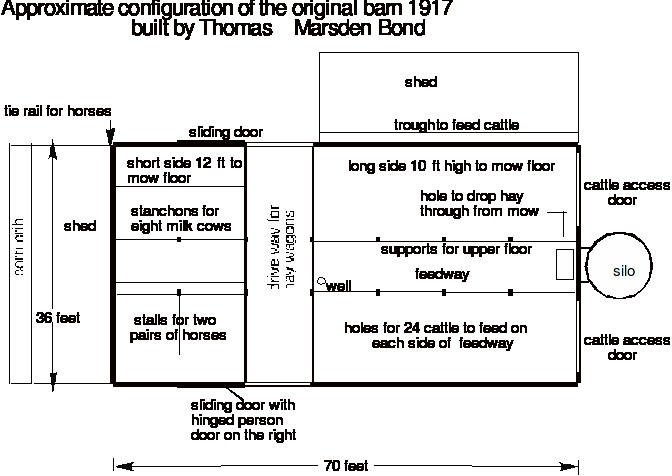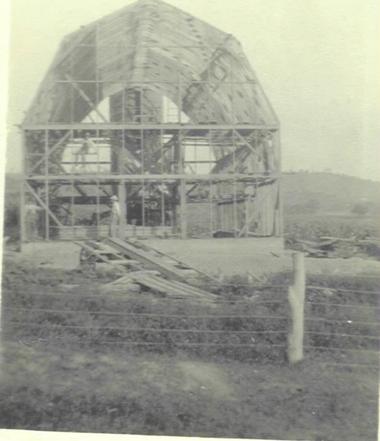
| Next Chapter | Previous Chapter | |
| Chapter 5: The Hay Mow | Contents | Chapter 3: Earliest Memories: 2. Horses and the Tractor |
One of the biggest differences in the way I have farmed since the 1960's and the way Dad farmed is that I do not use a barn. Grandfather (T. M.) Bond built the barn in 1917. He had grown up on Hackers Creek, and for reasons I never learned, got a farm for himself that once belonged to his father, Booth Bond. His terminal education was a one year business course at Alfred University in Alfred, New York. Seventh Day Baptists were very big on education in those days, and a lot of other people weren't. The education served him well.
About 1912 he, his wife, my grandmother, Bessie Clark Bond, and their children Lotta and Paul moved to the Moses H. Van Horn farm, the farm where I grew up, which I call "the Lost Creek farm." (It is the site of the earlier part of this book.) At first the grandparents rented it. At the beginning of WW I Grandpa took the family to Salem to work in the construction business and to have secondary and college opportunity for the children. As a child I understood he was part of management. Later I met some of the descendants of others in the business who thought he did not have an ownership. So I think he was sort of middle management in the firm, which was quite profitable, due to the oil boom and the war.
After the war (1917) he had enough money to go deeply in debt and buy the farm on Lost Creek, and build the 36 by 70 foot barn. Its function was the same as a feed lot now, a place to fatten young cattle. It was modeled after a barn on the McWhorter farm on Duck Creek which still stands. (That barn lost the mansard roof at the time of the great tornado of 1970s, and it was replaced with a common ridgepole roof). Our barn had a wooden silo with a roof, which was replaced by the present concrete stave silo in the late forties or early fifties.
(Illustration 4-1)

Barn Layout
The diagram above shows the best reconstruction I can make of the original barn. The older barn standing in front was pirated for hewn beams. The vertical timbers that supported the second floor in the interior of the barn came from the old barn, along with some of the timbers that lay on them for stringers supporting the second floor. The vertical timbers were kept up out of the manure by concrete pillars a little over a foot high. If they hadn't, they would have rotted in a short time, because the moisture and the nitrogen in manure are ideal to make the wood rot.
The short side of the hay mow (West) was originally scheduled to be ten feet above the concrete floor, just like the long side. Dad had the idea of making the ceiling over the horses higher, so they could suspend the harness over the horses with rope and pulley. The harness elevating system was gone by my
(Illustration 4-2)

Barn under construction
time, so harness had to be put on the hard way. The walls and feed troughs were made of two inch oak, because the horses had the habit of kicking walls repeatedly with iron shoes on, and chewing on the troughs. The person door in the lower sliding door was large enough to admit the horses or cows or sheep.
Cattle to be fattened were to be kept in the long side, and milk cows for the family and small sales were kept on the upper side, along with sick animals. (Later when I knew the barn there was a lot of wasted space in that area.)
I think the two sheds, especially the one on the west side with the corn crib were built when the barn was first built, or in a year or two. The rafters were rough poles of maple, covered with rough boards of local cut separated by twelve or fourteen inch breaks, supporting corrugated roofing. The reason for using maple was that it was available on the farm in the length and diameter needed and was not attacked by insects.. The only cuts were to trim off limbs and square the end that went in through the sheeting on the barn to rest on horizontal 2x 6's. The outer ends of these were supported by locust poles set in the ground every ten feet. The corn crib was about three feet wide made of 1 x 3 inch boards set on a diagonal. The idea was for the wind to blow through and remove the moisture from the corn. It was about 7 feet high, three feet off the ground, ten feet total height, remarkable only in that it was rather large. I have seen it full, with more ears piled on the ground in the shed between it and the barn.
The ear corn was used to fatten hogs, the primary meat of the time. The hogs also got household waste food, excess milk that could not be used or sold, and rarely, purchased feed. Rats found the corn, of course, but soon after them came the snakes. One time I was playing in the crib when it was half empty (my age was about ten), and started a landslide of corn. Out came a huge blacksnake, as scared as I was. The older folks knew how helpful they were, and didn't kill them, and always had a kind word for black snakes. They pretended to have learned this in college, but I suspect it was an attitude of the older family, too. Dad and Aunt Lotta had bachelor's degrees in Biology.
Concrete for the barn was mixed by hand, on the grounds, using rough fieldstone to extend the expensive purchased cement. Now, 80 years later, the roof is almost intact (due to much painting), and the southern pine and rough local lumber are almost intact, but the cement is breaking badly
There was a grain box for wheat against the west wall of the barn. It was tongue and groove pine perhaps six feet wide, four deep and four high with a tight top. I was allowed to play in it as a small child. It was usually empty. Only once in my youth do I remember thrashing wheat at home. Too little return for the ground used. Good for horses, but expensive in land and labor.
Aside One of the problems with wintering cattle in a barn is the huge amount of manure they generate. In the cold weather it was almost liquid, but by the time grass had gotten a start, the animals were out on pasture, and it was necessary to remove it to the fields for fertilizer, it was solid enough to lift with a fork.
One day when I was about fourteen, I was helping load the spreader. I was working with a four prong pitchfork, and Dad was on the other side using a silage fork about 16 inches wide and 14 inches long, going at it like a human machine. After some time I was worn out, and he was still going strong, so I said, "Don't you ever get tired?" His reply was that I "just didn't know the trick to it." "You shovel with your right hand nearest the fork, and throw it into the spreader on your right side for a while. Then you turn half way around, shovel with your left hand nearest the fork and throw it to the left for a while, TO REST."
| Next Chapter | Previous Chapter | |
| Chapter 5: The Hay Mow | Contents | Chapter 3: Earliest Memories: 2. Horses and the Tractor |
Copyright © 1998, 2006, 2008, 2011 S. Tom Bond (stombond at hughes.net)